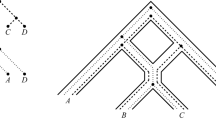Abstract
Understanding the face structure of the balanced minimal evolution (BME) polytope, especially its top-dimensional facets, is a fundamental problem in phylogenetic theory. We show that BME polytope has a sublattice of its poset of faces which is isomorphic to a quotient of the well-studied permutoassociahedron. This sublattice corresponds to compatible sets of splits displayed by phylogenetic trees and extends the lattice of faces of the BME polytope found by Hodge, Haws and Yoshida. Each of the maximal elements in our new poset of faces corresponds to a single split of the leaves. Nearly all of these turn out to actually be facets of the BME polytope, a collection of facets which grows exponentially.









Similar content being viewed by others
References
Atteson K (1999) The performance of neighbor-joining methods of phylogenetic reconstruction. Algorithmica 25(2):251–278. doi:10.1007/PL00008277
Billera LJ, Holmes SP, Vogtmann K (2001) Geometry of the space of phylogenetic trees. Adv Appl Math 27(4):733–767. doi:10.1006/aama.2001.0759
Catanzaro D, Labbé M, Pesenti R, Salazar-González JJ (2012) The balanced minimum evolution problem. INFORMS J Comput 24(2):276–294. doi:10.1287/ijoc.1110.0455
Desper R, Gascuel O (2002) Fast and accurate phylogeny reconstruction algorithms based on the minimum-evolution principle. J Comput Biol 9(5):687–705
Desper R, Gascuel O (2004) Theoretical foundation of the balanced minimum evolution method of phylogenetic inference and its relationship to weighted least-squares tree fitting. Mol Biol Evol 21(3):587–598
Eickmeyer K, Huggins P, Pachter L, Yoshida R (2008) On the optimality of the neighbor-joining algorithm. Algorithms Mol Biol. doi:10.1186/1748-7188-3-5
Forcey S (2014) Dear NSA: long-term security depends on freedom. Not AMS 61(1):7
Forcey S, Keefe L, Sands W (2016) Facets of the balanced minimal evolution polytope. J Math Biol 73(2):447–468
Gascuel O, Steel M (2006a) Neighbor-joining revealed. Mol Biol Evol 23(11):1997–2000
Haws DC, Hodge TL, Yoshida R (2011) Optimality of the neighbor joining algorithm and faces of the balanced minimum evolution polytope. Bull Math Biol 73(11):2627–2648. doi:10.1007/s11538-011-9640-x
Huggins P (2008) Polytopes in computational biology. Ph.D. Dissertation, UC Berkeley
Kapranov MM (1993) The permutoassociahedron, Mac Lane’s coherence theorem and asymptotic zones for the KZ equation. J Pure Appl Algebra 85(2):119–142. doi:10.1016/0022-4049(93)90049-Y
Pauplin Y (2000) Direct calculation of a tree length using a distance matrix. J Mol Evol 51:41–47
Reiner V, Ziegler GM (1993) Coxeter-associahedra. Technical Report, SC-93-11, ZIB, Takustr. 7, 14195 Berlin
Saitou N, Nei M (1987) The neighbor joining method: a new method for reconstructing phylogenetic trees. Mol Biol Evol 4:406–425
Waterman M, Smith T, Singh M, Beyer W (1977) Additive evolutionary trees. J Theor Biol 64(2):199–213. doi:10.1016/0022-5193(77)90351-4
Acknowledgements
We thank the editors and both referees for helpful comments. Stefan Forcey would like to thank the organizers and participants in the working group for geometric approaches to phylogenetic tree reconstructions, at the NSF/CBMS Conference on Mathematical Phylogeny held at Winthrop University in June–July 2014. Especially helpful were conversations with Ruriko Yoshida, Terrell Hodge and Matt Macauley. Stefan Forcey would also like to thank the American Mathematical Society and the Mathematical Sciences Program of the National Security Agency for supporting this research through Grant H98230-14-0121. (This manuscript is submitted for publication with the understanding that the United States Government is authorized to reproduce and distribute reprints.) Stefan Forcey’s specific position on the NSA is published in Forcey (2014). Suffice it to say here that he appreciates NSA funding for open research and education, but encourages reformers of the NSA who are working to ensure that protections of civil liberties keep pace with intelligence capabilities.
Author information
Authors and Affiliations
Corresponding author
Rights and permissions
About this article
Cite this article
Forcey, S., Keefe, L. & Sands, W. Split-Facets for Balanced Minimal Evolution Polytopes and the Permutoassociahedron. Bull Math Biol 79, 975–994 (2017). https://doi.org/10.1007/s11538-017-0264-7
Received:
Accepted:
Published:
Issue Date:
DOI: https://doi.org/10.1007/s11538-017-0264-7




